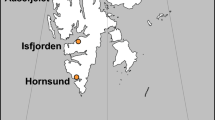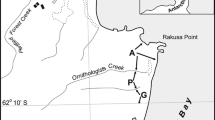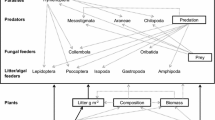Abstract
Aims
This study investigates how burrow-nesting, colonial seabirds structure the spatial patterns of soil and plant properties (including soil and leaf N) and tests whether burrow density drives these spatial patterns within each of six individual islands that vary greatly in burrow density.
Methods
Within individual islands, we compared semivariograms (SVs) with and without burrows as a spatial trend. We also used SVs to describe and compare the spatial patterns among islands for each of 16 soil and plant variables.
Results
Burrow density within a single island was only important in determining spatial structuring in one-fifth of the island-variable combinations tested. Among islands, some variables (i.e., soil pH, δ15N, and compaction; microbial biomass and activity) achieved peak spatial variance on intermediate-density islands, while others (i.e., net ammonification, net nitrification, NH4 +, NO3 -) became increasingly variable on densely burrowed islands.
Conclusions
Burrow density at the within-island scale was far less important than expected. Seabirds and other ecosystem engineers whose activities (e.g., nutrient subsidies, soil disturbance) influence multiple spatial scales can increase spatial heterogeneity even at high densities, inconsistent with a “hump-shaped” relationship between resource availability and heterogeneity.






Similar content being viewed by others
References
Abrams PA (1988) Resource productivity-consumer species diversity: simple models of competition in spatially heterogeneous environments. Ecol 69:1418–1433
Abrams PA (1995) Monotonic or unimodal diversity-productivity gradients: what does competition theory predict? Ecol 76:2019–2027
Anderson JPE, Domsch KH (1978) Physiological method for quantitative measurement of microbial biomass in soils. Soil Biol Biochem 10:215–221
Bangert RK, Slobodchikoff CN (2000) The Gunnison’s prairie dog structures a high desert grassland landscape as a keystone engineer. J Arid Environ 46:357–369
Baraloto C, Couteron P (2010) Fine-scale microhabitat heterogeneity in a French Guianan forest. Biotropica 42:420–428
Bardgett RD (2005) The biology of soil: a community and ecosystem approach. Oxford University Press, London
Bartels SF, Chen HYH (2010) Is understory plant species diversity driven by resource quantity or resource heterogeneity? Ecol 91:1931–1938
Bird MI, Tait E, Wurster CM et al (2008) Stable carbon and nitrogen isotope analysis of avian uric acid. Rapid Commun Mass Sp 22:3393–3400. doi:10.1002/rcm
Bruckner A, Kandeler E, Kampichler C (1999) Plot-scale spatial patterns of soil water content, pH, substrate-induced respiration and N mineralization in a temperate coniferous forest. Geoderma 93:207–223. doi:10.1016/S0016-7061(99)00059-2
Clark I (1979) Practical geostatistics. Elsevier Science and Technology, London
Ehleringer JR, Hall AE, Farquhar GD (1993) Stable isotopes and plant carbon/water relations. Academic, New York
Ewers BE, Pendall E (2008) Spatial patterns in leaf area and plant functional type cover across chronosequences of sagebrush ecosystems. Plant Ecol 194:67–83
Fischer JB, Griffin CR (2000) Can burrow-nesting seabirds be identified from their burrow dimensions? Wildlife Soc Bull 28:586–591
Fukami T, Wardle DA, Bellingham PJ et al (2006) Above- and below-ground impacts of introduced predators in seabird-dominated island ecosystems. Ecol Lett 9:1299–1307. doi:10.1111/j.1461-0248.2006.00983.x
Gallardo A (2003a) Effect of tree canopy on the spatial distribution of soil nutrients in a Mediterranean Dehesa. Pedobiologia 47:117–125
Gallardo A (2003b) Spatial variability of soil properties in a floodplain forest in northwest Spain. Ecosystems 6:564–576
Gallardo A, Rodríguez-Saucedo JJ, Covelo F et al (2000) Soil nitrogen heterogeneity in a Dehesa ecosystem. Plant Soil 222:71–82
Gillham ME (1956) Ecology of the Pembrokeshire islands: IV effects of treading and burrowing by birds and mammals. J Ecol 44:51–82
Gundale MJ, Fajardo A, Lucas RW et al (2011) Resource heterogeneity does not explain the diversity-productivity relationship across a boreal island fertility gradient. Ecography 34:887–896
Hawke DJ (2001) Variability of δ15N in soil and plants at a New Zealand hill country site: correlations with soil chemistry and nutrient inputs. Aust J Soil Res 39:373–383
Hobson KA, Piatt JF, Pitocchelli J (1994) Using stable isotopes to determine seabird trophic relationships. J Anim Ecol 63:786–798
Huston MA (1999) Local processes and regional patterns: appropriate scales for understanding variation in the diversity of plants and animals. Oikos 86:393–401
Huston MA, DeAngelis DL (1994) Competition and coexistence: the effects of resource transport and supply rates. Am Nat 144:954–977
Jones C, Lawton J, Shachak M (1994) Organisms as ecosystem engineers. Oikos 69:373–386
Li J, Richter DB, Mendoza A et al (2010) Effects of land-use history on soil spatial heterogeneity of macro- and trace elements in the southern piedmont USA. Geoderma 156:60–73. doi:10.1016/j.geoderma.2010.01.008
Markwell TJ, Daugherty CH (2003) Variability in δ15N, δ13C and Kjeldahl nitrogen of soils from islands with and without seabirds in the Marlborough sounds, New Zealand. New Zeal J Ecol 27:25–30
Mittelbach GG, Steiner CF, Scheiner SM et al (2001) What is the observed relationship between species richness and productivity? Ecol 82:2381–2396
Mizutani H, Kabaya Y, Moors PJ et al (1988) Nitrogen isotope ratios identify deserted seabird colonies. Auk 108:960–964
Mulder CPH, Keall SN (2001) Burrowing seabirds and reptiles: impacts on seeds, seedlings and soils in an island forest in New Zealand. Oecologia 127:350–360. doi:10.1007/s004420000600
Mulder CPH, Grant-Hoffman MN, Towns DR et al (2009) Direct and indirect effects of rats: does rat eradication restore ecosystem functioning of New Zealand seabird islands? Biol Invasions 11:1671–1688. doi:10.1007/s10530-008-9396-x
Mulder CPH, Jones HP, Kameda K et al (2011) Impacts of seabirds on plant and soil properties. In: Mulder CPH, Anderson WB, Towns DR, Bellingham PJ (eds) Seabird islands: ecology, invasion, and restoration. Oxford University Press, New York, pp 135–176
Oloffson J, de Mazancourt C, Crawley MJ (2008) Spatial heterogeneity and plant richness at different spatial scales under rabbit grazing. Oecologia 156:825–834
Questad EJ, Foster BL (2007) Vole disturbances and plant community in a grassland metacommunity. Oecologia 153:341–345
Ribeiro PJ, Diggle PJ (2001) GeoR: a package for geostatistical analysis. R-News 1:15–18
Robertson GP, Crum JR, Ellis BG et al (1993) The spatial variability of soil resources following long-term disturbance. Ecology 96:451–456
Robertson GP, Sollins P, Ellis BG et al (1999) Exchangeable ions, pH, and cation exchange capacity. In: Robertson GP, Coleman DC, Bledsoe CS, Sollins P (eds) Standard soil methods for long-term ecological research. Oxford University Press, New York, pp 55–73
Rodríguez A, Durán J, Fernández-Palacios JM et al (2009) Spatial variability of soil properties under Pinus canariensis canopy in two contrasting soil textures. Plant Soil 322:139–150
Russell JC, McMorland AJC, MacKay JWB (2010) Exploratory behavior of colonizing rats in novel environments. Anim Behav 79:159–164
Sherrod SK, Seastedt TR (2001) Effects of the northern pocket gopher (Thomomys talpoides) on alpine soil characteristics, Niwot Ridge, CO. Biogeochemistry 55:195–218
Smith JL, Mulder CPH, Ellis JC (2011) Seabirds as ecosystem engineers: nutrient inputs and physical disturbance. In: Mulder CPH, Anderson WB, Towns DR, Bellingham PJ (eds) Seabird islands: ecology, invasion, and restoration. Oxford University Press, New York, pp 27–55
Steinauer EM, Collins SL (2001) Feedback loops in ecological hierarchies following urine deposition in tallgrass prairie. Ecol 82:1319–1329
Stevens MHH, Carson WP (2002) Resource quantity, not resource heterogeneity, maintains plant diversity. Ecol Lett 5:420–426. doi:10.1046/j.1461-0248.2002.00333.x
Su YZ, Li YL, Zhao HL (2006) Soil properties and their spatial pattern in a degraded sandy grassland under post-grazing restoration, inner Mongolia, Northern China. Biogeochemistry 79:297–314
Towns DR, Byrd GV, Jones HP et al (2011) Impacts of introduced predators on seabirds. In: Mulder CPH, Anderson WB, Towns DR, Bellingham PJ (eds) Seabird islands: ecology, invasion, and restoration. Oxford University Press, New York, pp 56–90
Wait D, Aubrey D, Anderson W (2005) Seabird guano influences on desert islands: soil chemistry and herbaceous species richness and productivity. J Arid Environ 60:681–695. doi:10.1016/j.jaridenv.2004.07.001
Wardle DA (1993) Changes in the microbial biomass and metabolic quotient during leaf litter succession in some New Zealand forest scrubland ecosystems. Funct Ecol 7:346–355
Wardle DA (2002) Communities and ecosystems: linking the aboveground and belowground components. Princeton University Press, Princeton
Wardle DA, Bellingham PJ, Fukami T et al (2007) Promotion of ecosystem carbon sequestration by invasive predators. Biol Lett 3:479–482. doi:10.1098/rsbl.2007.0163
Wardle DA, Bellingham PJ, Bonner KI et al (2009) Indirect effects of invasive predators on litter decomposition and nutrient resorption on seabird-dominated islands. Ecology 90:452–464
Warham J (1990) The petrels: their ecology and breeding systems. Academic, London
Wilks SS (1938) The large-sample distribution of the Likelihood Ratio for testing composite hypotheses. Ann Math Stat 9:60–62. doi:10.1214/aoms/1177732360
Worsham L, Markewitz D, Nibbelink N (2010) Incorporating spatial dependence into estimates of soil carbon contents under different land covers. Soil Sci Soc Am J 74:635–646
Wu H, Batzer DP, Yan X et al (2013a) Contributions of ant mounds to soil carbon and nitrogen pools in a marsh wetland of Northeastern China. Appl Soil Ecol 70:9–15
Wu H, Lu X, Wu D et al (2013b) Ant mounds alter spatial and temporal patterns of CO2, CH4, and N2O emissions from a marsh soil. Soil Biol & Biochem 57:884–891
Yoshihara Y, Ohkuro T, Buuveibaatar B et al (2009) Effects of disturbance by Siberian marmots (Marmota sibirica) on spatial heterogeneity of vegetation at multiple spatial scales. Grassland Sci 55:89–95
Yoshihara Y, Ohkuro T, Buuveibaatar B et al (2010) Clustered animal burrows yield higher spatial heterogeneity. Plant Ecol 206:211–224
Acknowledgements
For permission to work on the islands they own or for which they are kaitiaki (guardians), we thank Ngāti Hako and Ngāti Hei, as well as the Ruamahua (Aldermen) Islands Trust and the Neureuter family. We thank the New Zealand Department of Conservation for facilitating our visits to the islands they administer. We also thank Nicholas Aitken, Peter Bellingham, Karen Bonner, Larry Burrows, Ewen Cameron, Tad Fukami, Jessica Garron, Nikki Grant-Hoffman, Aaron Hoffman, Holly Jones, Brian Karl, Rau Kirikiri, Jamie MacKay, Richard Parrish, Gaye Rattray, James Russell, Dave Towns, and Dan Uliassi for lab and field assistance. Reviews by Roger Ruess and Mat Wooller improved the original manuscript. This study was financially supported by the Marsden Fund of the Royal Society of New Zealand, the U.S. National Science Foundation (DEB-0317196), the New Zealand Foundation for Research, Science, and Technology (Te Hiringa Tangata kit e Tai Timu ki te Tai Pari Programme), the New Zealand Department of Conservation, a summer research fellowship to M. Durrett from the Institute of Arctic Biology, a dissertation completion fellowship to M. Durrett from the University of Alaska Fairbanks Graduate School, and the Dean Wilson Scholarship to M. Durrett from the Alaska Trappers Association.
Author information
Authors and Affiliations
Corresponding author
Additional information
Responsible Editor: Eric Paterson.
Electronic supplementary material
Below is the link to the electronic supplementary material.
Online Resource 1
Seabird burrow density calculations and modeling (PDF 561 kb)
Online Resource 2
Anisotropic modeling (PDF 117 kb)
Rights and permissions
About this article
Cite this article
Durrett, M.S., Wardle, D.A., Mulder, C.P.H. et al. Seabirds as agents of spatial heterogeneity on New Zealand’s offshore islands. Plant Soil 383, 139–153 (2014). https://doi.org/10.1007/s11104-014-2172-z
Received:
Accepted:
Published:
Issue Date:
DOI: https://doi.org/10.1007/s11104-014-2172-z




